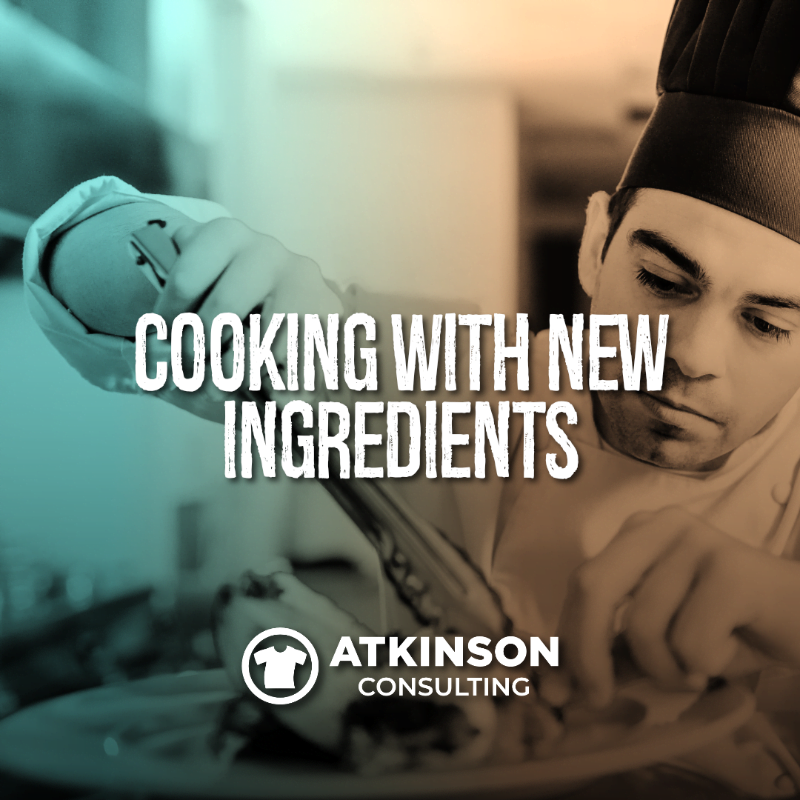Have you ever tried cooking with new ingredients? You know, the recipe calls for a list of items in exact measurements, but you can’t resist the urge to throw in some honey and cayenne pepper.
This is how chefs and home cooks all over the globe turn a standard dish into something spectacular and their own.
It’s also how chefs and home cooks the world over ruin dinner in about two seconds flat.
To get to the victory circle sometimes you have to be willing to ruin dinner. Or at least practice enough that you have a good chance to change something without ruining it, but still making it your own.
In this article, I want to explore some ways that you can spice things up in your shop by cooking with new ingredients.
Ready?
First, Start Here
Let’s unpack the why you should even try this to begin with.
In our industry, what makes a decorated apparel shop unique? How are you standing out from the crowd?
Screen printing a shirt isn’t that difficult. Neither is embroidering a logo on a button-down or digitally printing a t-shirt for an online store purchase.
The quickest way to staying a commodity is to be like everyone else. When your recipe tastes like everyone else’s, nobody will line up around the block to work with you.
Example: Chef Alain Ducasse
Currently, Chef Alain Ducasse has the most current Michelin stars at 17. He owns 36 restaurants across the globe and is known primarily for his world-class French cuisine. At The Dorchester in London, his seven-course tasting experience for two people will set you back $537. My guess is that it is fantastic.
But it isn’t for everyone.
Chef Ducasse spends his time creating out-of-this-world cuisine for people with a taste for French food and who can afford to dine at his restaurants. He has spent a lifetime creating an experience and food that is different from everyone else to rise to the top in his industry.
That is how he is commanding $537 for a dinner.
Chef Ducasse knows his why. He understands his audience and target market. In the restaurant world, Michelin stars are incredibly difficult to obtain. He has 17.
If you look behind the scenes I’ll bet you can find an incredible support team, the best equipment, and the freedom and time to experiment on new ideas to bring to market. A man with 17 Michelin stars isn’t sitting around dreaming of past glory. He knows his “why” and how it aligns with his customers best.
What is your “why?” How are you different than anyone else that can decorate a shirt?
What ingredients do you cook with? Are you adding honey and cayenne pepper to something?
The Ingredient List
For our industry, if we want to be cooking with new ingredients we should spend a few moments outlining what that means. Chef Ducasse might be a stickler for the finest meats, spices, and wine. He knows what’s needed to make diners tear up when they bite into a forkful of his food.
“Oh mon dieu, c’est la meilleure chose que j’ai jamais mangée!“
So I have to ask you, what ingredients go into your cooking? For us, we aren’t using tarragon, capers, or garlic.
It’s the inks, emulsion, squeegees, special effects, thread, and assorted other consumables that add up to success. Garments that we decorate play an important role, after all, you aren’t printing or embroidering air.
Does a professional chef source the cheapest deal they can find? Or, do you think they are highly selective about what they allow in the kitchen?
They have to make money too. Everything they buy has to be transformed into the product that they gently place on a white linen-draped table.
It isn’t the cost of the ingredients for you that you should be concerned about, but the performance. Often, better choices cost more.
How are you evaluating the ingredients in your shop? Do you even think about it? When was the last time you tried something new just to see how the results might turn out?
Your Cooking Team
In Chef Ducasse’s restaurants, he actually isn’t the one doing the cooking every day. Rather, he’s like the conductor of an orchestra and his role is to make sure that the supporting team handles their roles to perfection.
He might buy the best ingredients, but if they aren’t chopped right, cooked at the right temperature, or assembled together in the precise measurements that he builds in the recipe, then the final result won’t match expectations.
The same goes for your shop.
As my friend Greg Kitson says, “I have news for you kid, you are not in the screen printing business…you are in the screen MAKING business.” This is true. It also carries over to embroidery, digital printing, laser-etching, sublimation, or any other process in your shop.
The mechanics of how you use those ingredients to build the final result for each order your produce always matter.
Example: Double Stroking the Underbase
Unless you are printing with waterbase inks, you shouldn’t have to double stroke an underbase screen on an automatic press. Yet, shops do this all the time because they desire better opacity for that foundational screen.
But, it is a band-aid for poor press management and screen building.
Every time you double hit that screen, you use twice as much ink and twice as much time. What do you think the annual cost of that might be? How much more flash dwell time is needed to gel that thicker deposit before the shirt can move to the next color?
Instead, what if you chose to make better screens? This is akin to using fresher ingredients in a favorite recipe. What a world of difference it will make.
This is a function of the line chefs in your shop’s screen room. Better tension, better emulsion coating, better exposure, and better wash-out can all have a transformational effect of getting to a one-hit underbase.
This will allow you to print faster, have less flash dwell time, and a softer hand print.
This starts with you questioning and digging into what you need to change.
Example: Thread Breaks in Embroidery
Just like with screenprinting, there is a common problem found with embroidery shops that can be the Achilles Heel. That is the dreaded thread break.
In your shop, how are you controlling this? Is it in an ingredient element, such as using better thread, the right needle, or bobbin tension?
Maybe it is in the set up of your machine, and you have challenges with the bobbin, thread spool, throat plate, or pressure.
It could just be with how the design is digitized.
As shops constantly sew different types of garments, designs, and needs it is important that your embroidery crews know how to troubleshoot these challenges and make adjustments.
That’s why chefs the world over actually taste the food they are serving.
Your cooking team in embroidery needs to be trained on how to adjust the different elements to produce the best results. Just like you can’t cook everything the same way, you can’t sew everything the same way either.
Example: DTG Pretreatment
Similar to the underbase in screen printing, the pretreatment step for direct to garment digital printing is crucial to your success.
As with salt in a recipe, too little or too much can completely ruin the outcome. You want just the right amount.
This means having control over how the pretreatment fluid is applied. Dial-in the right amount, and in only the areas you need it.
Sadly, I’ve been to shops that spray so much pretreatment on the shirt that it gets over-saturated. Then, to make matters worse, they use a heat press to dry the pretreatment fluid on the surface of the shirt. But, there is so much fluid on the shirt that the heat press only dries the area under the heating element…not what was dripping down the sides of the shirt.
This causes staining and other issues that ruin the shirt. Yep. Too much salt. Yuck.
How are you controlling the pretreatment in your DTG print department? Also, do you have regularly scheduled preventative maintenance on the pretreatment machine or applicator so the nozzles don’t become clogged?
Great chefs have steps like this dialed in and controlled. Do you?
Cooking with Pots and Pans
Chefs are picky people. They keep their knives razor-sharp. The kitchens they work in are constantly cleaned and are immaculate. Sourcing the best ingredients for their cuisine is serious business.
For kitchen staff, anything they use constantly is less than an arm’s length away. In fact, there is a term for that, “mise-en-place,” which is French for “everything in its place.”
Now let’s talk about your shop.
If Chef Alain Ducasse toured your shop and compared it to a kitchen, would he be thrilled or disappointed at your level of cleanliness and organization?
Are you exact and crystal clear in your instructions and expectations for your crew? I’m quite positive that Chef Ducasse has his restaurant staff trained to carry out his vision. They know exactly what to do next, and how it should be performed.
What about yours? What’s keeping you in the weeds?
What to Focus On
I get it. You are not a world-famous chef.
But, we can use the elements of a chef to try to become the best to improve how your shop runs, and how that might differentiate your company from everyone else.
To me, to surge past the competition there are really only two things that I would focus on.
Behaviors
Outcomes
Why these two? Because I think if you get down to the nitty-gritty of these two ideas, you can distinguish your business from the rest of the pack. Especially if we throw in the notion of the idea of ingredients.
Let’s take a look.
Behaviors
What is behavior? For a world-acclaimed chef, what type of behaviors do you think Alain Ducasse exhibits on a day-to-day basis? I don’t personally know the guy, but based on his world-renown professional level I’ll bet he has:
- Relentless curiosity
- Exacting standards
- A low tolerance for under-performing anything
- A highly organized way of handling processes
- Business savvy
- Pride in his work
- The ability to teach others
- Always been open to new ideas
So when we think about using new ingredients in your business to develop some market differentiation between you and your competition, how do these behaviors make a difference?
Do you think he has trouble finding or keeping staff?
What processes do you think they have built over the years to be able to perform at such a high and exacting level?
I want you to imagine that you could shadow Chef Ducasse for a day. What do you think you could learn and reverse engineer for your own business to help it dominate the market?
What behaviors do you tolerate in your shop that are nowhere to be found in his restaurants? Why are they ok for you?
Outcomes
At the end of the day we are always being judged by our customers.
In the restaurant business, developing a loyal following of repeat customers is the key to growth. Sound familiar?
It doesn’t take much these days for customers to abandon you and go somewhere else. Especially if all you are offering is ink or thread on a garment. That’s not much of a differentiator.
You don’t get 17 Michelin stars by just serving good food. It is the total experience that is winning these awards and acclaim.
People eat with their eyes first. Then the aroma takes over. Finally, the taste buds kick in.
Great restaurants excel in performance art. They deliver on the clarity of the expected outcome. The ambiance of the room. A friendly and knowledgeable staff. How you are treated. Matching your mind’s eye expectations for the meal with reality. Your happiness comes first.
After you leave, would you come back? I’ll bet they would love for you to book a table for two next week. Especially if you are dropping $537 for dinner.
The decorated apparel industry isn’t much different. If you only focus on the product, you are missing out on many of the factors that keep customers coming back for more.
What are the key outcomes that you need to hit on a consistent basis? Do you know?
- Do you understand what your customer needs?
- How is order information handled?
- Do you create and consistently hit deadlines?
- In your shop, do you have processes that everyone follows?
- Does everyone know what to do next?
- How long should something take?
- What does quality mean?
- Are you organized and work clean?
- How are you learning new information?
Is that in alignment with the mind’s eye expectations with your customers? Have you verified this somehow, or are you just guessing?
How many new customers turn into repeat customers? But, like for a restaurant, are they booking a table next week?
Are the ingredients you use for cooking matching the flavor palette of your customers? When they keep demanding something, such as online sales, or water-based ink, or laser-etched leather patches…are you learning to cook these dishes? Or do you say that you can’t put them on the menu?
Maybe sticking to your same old boring routine way of conducting business has meant a drop in sales lately?
Time for some new ingredients.
“Cooking is like painting or writing a song. Just as there are only so many notes or colors, there are only so many flavors – it’s how you combine them that sets you apart.” – Wolfgang Puck
“The most important single ingredient in the formula for success is knowing how to get along with people.” – Theodore Roosevelt
“No rules. Don’t be afraid to do whatever you want. Cooking doesn’t have to have rules. I don’t like it that way.” – Masaharu Morimoto
Help Support This Blog

If you like this blog and would like to support it, you can:
- Buy a book.
- Share this blog on your social media.
- Join Shirt Lab Tribe.
- Subscribe to the Success Stories podcast.
- Watch and like an episode on the Jerzees Adventures in Apparel Decorating YouTube series.
Thanks!





